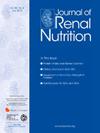The Association of Odor Identification With Nutritional Status and Systemic Inflammation in Patients With Advanced Chronic Kidney Disease
IF 3.4
3区 医学
Q2 NUTRITION & DIETETICS
引用次数: 0
Abstract
Objectives
Anorexia is common in patients with chronic kidney disease (CKD) and could lead to protein-energy wasting (PEW). An altered sense of smell, a reflection of olfactory dysfunction, is a potential mechanism that exacerbates the impact of anorexia on PEW. In this study, we examined the extent of the altered sense of smell and its association with PEW in patients with moderate-to-advanced CKD.
Methods
We studied 139 individuals (34 healthy subjects– controls, 50 patients with stage 3-4 CKD, and 55 patients on maintenance hemodialysis (MHD)) using the odor identification test (Sniffin’ Sticks odor screening test containing 12 different smells). The odor identification test was scored as either correct or incorrect, and each participant's total odor score was calculated. Malnutrition inflammation score (MIS) was used to assess PEW.
Results
Patients with CKD had higher C-reactive protein and lower serum albumin concentrations compared to healthy individuals. Total odor scores were different between groups, with controls having the highest scores and MHD patients having the lowest scores. A similar difference was observed in MIS, and MHD patients displayed the worst nutritional score (P ≤ .001). The number of participants with severe olfactory dysfunction (≤6 correct answers) was significantly higher in the CKD and MHD groups compared to the controls (P ≤ .01). There was an inverse trend between the total odor score and the MIS score for the study population. However, this relationship was not statistically significant (r = −0.124, P = .21).
Conclusion
This cross-sectional study suggests that olfactory dysfunction, as assessed by the odor identification test, is altered in patients with advanced CKD, most notably in ones on MHD. Although the diminished sense of smell was observed alongside development of PEW, we explicitly noted that there is no statistically significant correlation.
晚期慢性肾病患者气味识别与营养状况和全身炎症的关系
背景:厌食症在慢性肾脏病(CKD)患者中很常见,可导致蛋白质能量消耗(PEW)。嗅觉改变是嗅觉功能障碍的一种反映,是加剧厌食对蛋白质能量消耗影响的潜在机制。在这项研究中,我们研究了中晚期慢性肾脏病患者嗅觉改变的程度及其与能量耗损的关系:我们使用气味识别测试(Sniffin' Sticks气味筛选测试,包含12种不同的气味)对139人(34名健康受试者--对照组、50名3-4期慢性肾脏病患者、55名维持性血液透析患者--MHD)进行了研究。气味识别测试分为正确和错误两种,并计算出每位参与者的气味总分。营养不良炎症评分(MIS)用于评估 PEW:结果:与健康人相比,慢性肾脏病患者的 C 反应蛋白(CRP)较高,血清白蛋白浓度较低。各组之间的气味总分不同,对照组得分最高,而营养不良症患者得分最低。在 MIS 中也观察到类似的差异,MHD 患者的营养评分最差(p ≤ 0.001)。与对照组相比,CKD 组和 MHD 组出现严重嗅觉功能障碍(正确答案少于 6 个)的人数明显较多(p ≤ 0.01)。在研究人群中,气味总分与 MIS 分数之间呈反比趋势。然而,这种关系在统计学上并不显著(r = -0.124,p = 0.21):这项横断面研究表明,通过气味识别测试评估的嗅觉功能障碍在晚期慢性肾脏病患者中发生了改变,尤其是在使用 MHD 的患者中。虽然在观察到嗅觉减退的同时也发现了PEW的发展,但我们明确指出,两者之间并无统计学意义上的显著相关性。
本文章由计算机程序翻译,如有差异,请以英文原文为准。
求助全文
约1分钟内获得全文
求助全文
来源期刊

Journal of Renal Nutrition
医学-泌尿学与肾脏学
CiteScore
5.70
自引率
12.50%
发文量
146
审稿时长
6.7 weeks
期刊介绍:
The Journal of Renal Nutrition is devoted exclusively to renal nutrition science and renal dietetics. Its content is appropriate for nutritionists, physicians and researchers working in nephrology. Each issue contains a state-of-the-art review, original research, articles on the clinical management and education of patients, a current literature review, and nutritional analysis of food products that have clinical relevance.
 求助内容:
求助内容: 应助结果提醒方式:
应助结果提醒方式:


